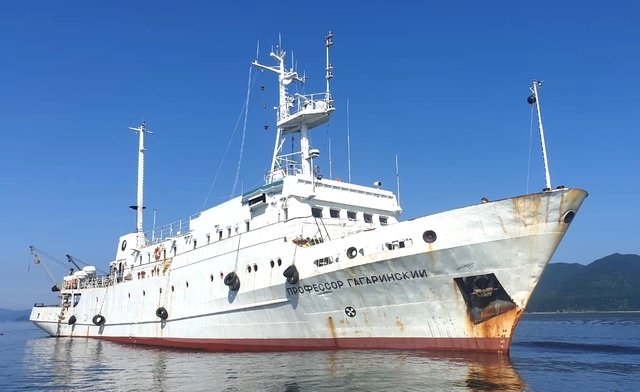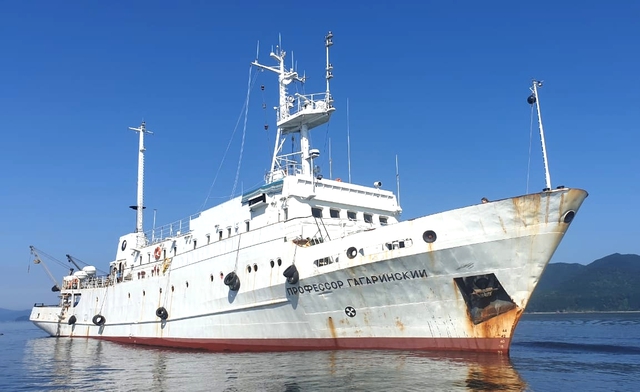On May 11, 2025, a significant event took place in the city of Vladivostok – the transfer of the scientific research vessel, “Professor Gagarinsky,” from Russia to Vietnam, witnessed by Senior Lieutenant General Hoang Xuan Chien (Deputy Minister of National Defense) and Mr. Konstantin Ilyich Mogilevsky (Deputy Minister of Science and Higher Education of the Russian Federation). Now, the “Professor Gagarinsky” is en route to its new home in Vietnam.
The vessel departed from Vladivostok on May 12 and is expected to arrive at Hai Phong port on May 25. “The transfer of the research vessel (RV) ‘Professor Gagarinsky’ symbolizes the traditional friendship and comprehensive strategic partnership between Vietnam and Russia. In just ten days, the ship will reach Hai Phong port. Scientists from the Vietnam-Russia Tropical Center will have the opportunity to conduct research in Vietnam’s distant seas. We are committed to utilizing the vessel most efficiently and achieving new scientific results,” said Senior Lieutenant General Hoang Xuan Chien.

The “Professor Gagarinsky” research vessel.
The “Professor Gagarinsky” is not just a scientific research vessel but also holds strategic significance for Russia. The ship enables Russian scientists to conduct continuous research in the tropics, focusing on elements such as water composition, biodiversity, ocean currents, and marine resources.
The “Professor Gagarinsky” has served Russia’s marine scientific research for 38 years (as of its transfer to Vietnam in May 2025), showcasing its durability and reliable performance in scientific research missions. While specific details of its achievements are not widely disclosed in public sources.
However, with its modern laboratories, the vessel can play a role in seafloor mapping, studying geological structures and seismic phenomena in Russian seas, especially in the Far East. This data is valuable for a better understanding of seabed mineral resources and geological processes.
An Interesting Aspect of the Vessel’s Voyage to Vietnam
An intriguing aspect of the “Professor Gagarinsky’s” journey to Vietnam is that it marks the first joint scientific mission between Russian and Vietnamese scientists. On this voyage, they are conducting their first collaborative marine research along the 3,400-kilometer route from Vladivostok to Hai Phong.
This not only demonstrates the vessel’s capability for continuous operation in offshore conditions but also highlights the close and effective cooperation between Vietnam and the Russian Federation. It also underscores the importance both countries place on marine research.

Scenes from the handover ceremony of the “Professor Gagarinsky” to the Vietnam-Russia Tropical Center. Image credit: Russian Government Press Service
The immediate initiation of research during the voyage showcases the swift and proactive coordination between scientists from both nations, reflecting a strong commitment to maximizing the ship’s potential for scientific collaboration. It also emphasizes the urgent need to explore, understand, and conserve marine ecosystems, biodiversity, and resources.
Moreover, instead of waiting for the vessel’s arrival in Vietnam, the scientists utilized the voyage to collect data and conduct experiments, exhibiting a professional work ethic and optimizing the ship’s time and resources. This also highlights the thorough preparation and well-planned research agenda between the two countries.
The “Professor Gagarinsky’s” State-of-the-Art Scientific Equipment
The “Professor Gagarinsky” is equipped with modern laboratories. Coupled with its size, researchers can utilize it for work in both offshore and coastal areas.
– Geophysics Laboratory: Supports research on seabed geological structures, terrain features, and seismic activities.
– Hydrography Laboratory: Analyzes physical and chemical properties of seawater, including temperature, salinity, currents, and chemical composition.
Additionally, the ship has a data and information processing room, allowing scientists to analyze collected data onboard during expeditions.
The “Professor Gagarinsky” was built in 1987 in Khabarovsk, southeastern Russia.
Class: KM * L2 I1I A2
Operating area: unlimited.
Length: 55.76 meters; Width: 9.49 meters; Height: 5.16 meters; Displacement: 1157 tons; Carrying capacity: 329 tons; Maximum/operating speed: 12/10 knots.
Capacity: Crew – 23 people; Scientists – 17 people.
Research can be conducted in both offshore and coastal areas.
Source: Port News/Russia
(According to the Ministry of Science and Higher Education of the Russian Federation, Port News)
US-Vietnam Collaboration: Advancing AI and Semiconductor Partnerships
“As part of their business trip to the United States to attend the SelectUSA 2025 conference, the Ministry of Finance’s delegation worked with Meta and Intel to foster collaboration in artificial intelligence and semiconductors. The delegation aimed to strike a balance between trade and high-tech development through these strategic partnerships.”
The Swine Industry’s First-Quarter Feast
The impressive surge in piglet prices, averaging a 40% increase compared to Q1/2024, has been a boon for the swine industry. This significant rise in prices has translated into a prosperous period for most pig farmers and businesses.





















